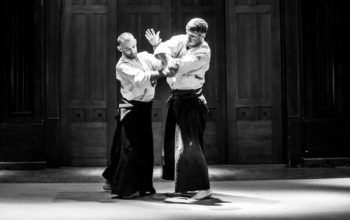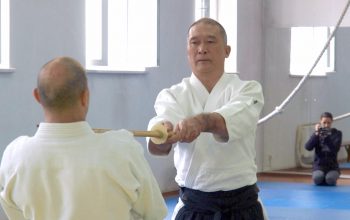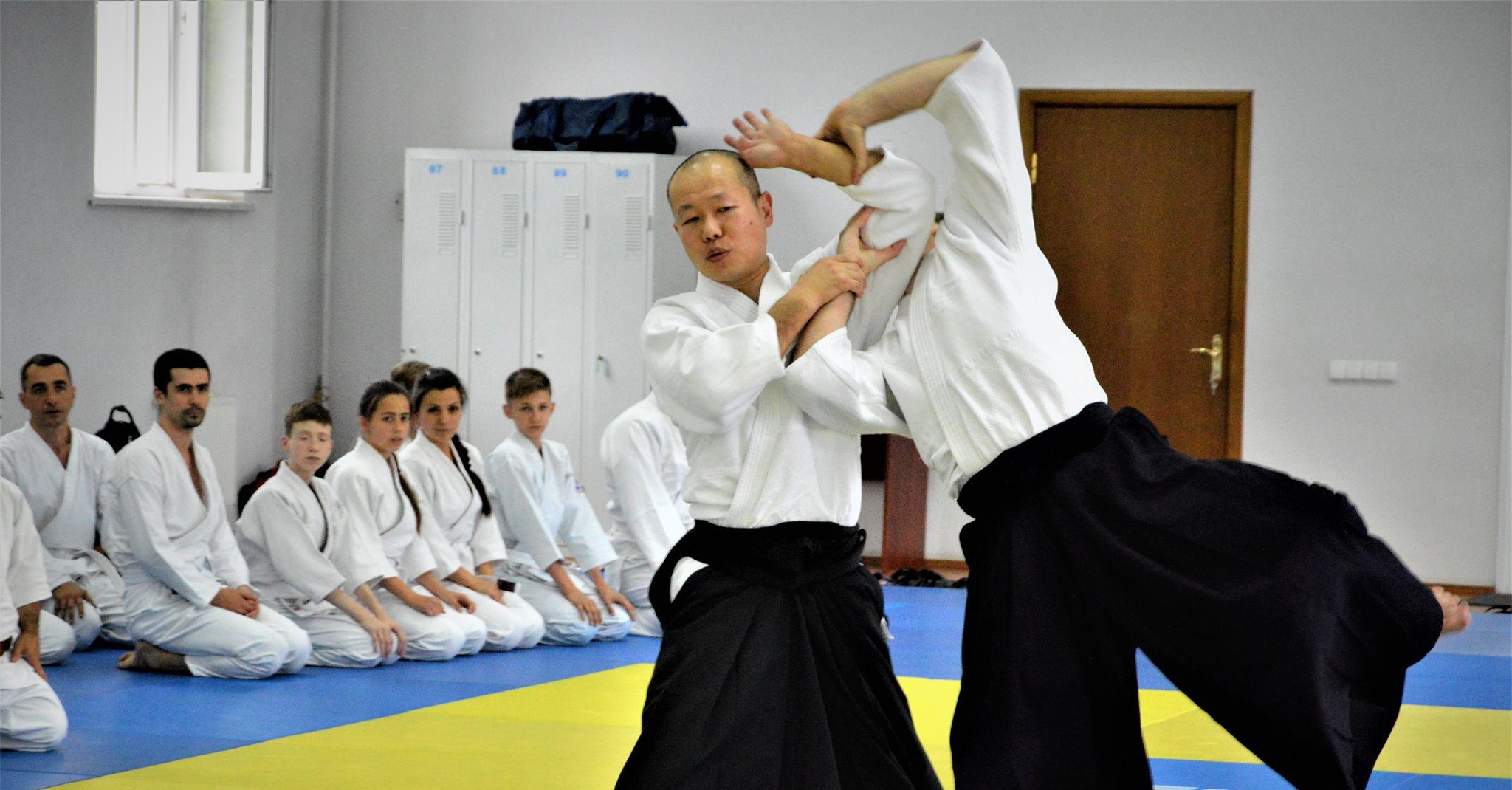
Yasuno Masatoshi was born on September 7, 1948 in Kanazawa city which is in the Ishikawa prefecture, Japan. Yasuno Masatoshi is a Hombu Shihan with a 8 Dan Aikikai rang and is considered to be Yamaguchi Sensei’s technique heir along with the Seishiro Endo, Yoshinobu Takeda and Christian Tissier.
This article is a translation from Italian of the original 2 interviews with Yasuno Shihan taken by the Budointernational in 2014.
What motivated you to take the Aikido road?
Aikido was very little known in Kanazawa, where I am originally from. I was able to discover Aikido only at the age of 18 upon my arrival in Tokyo thanks to the reference in a guide for students entering the university. I was very impressed by the fluidity of movements and the vitality of the techniques of Uchi and Tsuki. By the way, it was thanks to Aikido that my selfish and stubborn character has been tempered.
Seigo Yamaguchi was in charge at Universities Club of Aikido.
When you decided to teach Aikido?
As I trained more and more, I went deeper into the meaning of the art until I attained a higher appreciation of it and, while engaged in my daily occupations and my obligations in life, I asked myself what are the most important things in my life? I realized then how much keiko meant in my life. In addition, my teacher, Seigo Yamaguchi, noticed the originality of my movements and proposed me to teach at the Hombu Dojo. I did not hesitate to accept right away.
Yasuno Masatoshi started teaching aikido in Hombu dojo in 1973, at the age of 24 years.
What importance do the kokyu (breathing) have for you? Do you think it is necessary to improve it during the trainings?
Every form of life needs to breathe and to stop breathing means to die, therefore, breathing is intimately related to movement. The kokyu in Aikido is this movement itself, the origin of the vital energy that connects us with the most internal aspects of our body and mind and allows us to express ourselves and be aware of ourselves to make the most of every moment, all of which materializes in the execution of the technique. On the practical level it allows us to take the right distance from the partner, perceive their state of mind, body attitude while we adopt a correct posture and remain calm. This is not achieved without constant practice over time, of course.
Do you think your movement speed is a determining factor in Aikido?
Movement speed you say? The speed of movement is not important as a standalone. We can even get confused in the technique by going too fast and the same happens with the opposite, excessively slow. Therefore, we must try to be a little faster than the partner, that is the main thing if we want to leave a situation of urgency in the end. In terms of the inner state (spirit), it means being awake, alert, in other words “always ahead of the movement” and then we can “get” the partner. We must always “lead” the situation and never allow ourselves to be controlled.
What do you think about the practice with the weapons?
Aikido is also called “fencing without a sword” or “the art of the stick without a stick”, however, that does not mean that you should not study the handling of weapons. Shinkage-ryu says: “The unarmed practice is equivalent to adopting a non-violent attitude to resolve a conflict without actually fighting” which does not mean that we do not have to use some techniques if necessary. At least we should know about the possible injury a weapon can harm and that is why we practice weapons. When we observe the principles of Budo and the teachings of O’sensei, we realize that the concentration of the force is very important during a keiko and it is better exercised if we complement the weapons. This is why Budo can not be taken lightly if our intention is to practice seriously. It can even become counterproductive. For me It is always good to re-read the classic texts of professional swordmans.
You teach your students to improve flexibility rather than physical strength. What is the advantage from this teaching?
The physical strength, the strength of Kokyu and flexibility are very close: the fact of training flexibility leads to a better Kokyu, the fact of training the Kokyu leads to a much higher strength.
It is not my intention to deny the potential of physical strength, in reality it is preferable to have more strength, especially in your arms, but the most important thing is to know how to use this force effectively through our movements. The person who possesses the strength, to be able to use it effectively, must have a flexible mind (thought) and body (muscles, joints). As the phrase taught by my master: “Give a birth to the movement of the body from the flexibility of the heart”. For example, during weight training, a person used to lift 50 kg tries to lift 60 kg. In my case I would try to halve or reduce my Taisabaki to a third.
Do you believe that Aikido is defense Martial Art only?
Aikido is a Budo, so there is no interest in the practice it if it does not work in a combat. The technique of defense lies in practicing with different people, being in touch with their technique, with their strength of mind and understanding how use oneself according to the information received. I try to transmit the freedom not to depend on pre-established decisions in my classes.
What is the best way to use atemi?
Atemi allows an entrance to be applied and we see a good technique as a final result. It is a movement that comes from the bottom of the belly where the hara is to reach a vital point of the opponent or to break his concentration. The Atemi makes it possible to detect the partner’s inattention and imprudence and also to check the Mae (distance) between himself and his adversary. In kendo it is said that “the fact of cutting (Kiri) belongs to the domain of reason and the fact of touching (tsuki) belongs to the domain of intuition”. Therefore, atemi, which is like a tsuki, is extremely important when one wants to train intuition and sensitivity.
Are there more important techniques than others? Do you think that Ikkyo is the principle of all?
What is a principle? Let’s split the techniques from forms in a first place. For me the technique (waza) is more important than the form (kata) and I refer to techniques such as Ikkyo, Irimi or Shihonage. It is important to take the right distance in order to obtain an integrated movement (ikkyo), keeping the sutemi (irimi) and thus force the partner to move (shihonage). Ikkyo, in Japanese, is written with the sign of “one” and “learn”. I think this name derives from finding Ikkyo’s presence in the course of practicing more techniques. “One” means something very large: the beginning and the end. Technique is one, this “one” means everything.
What do you think of the comparison between sitting techniques (suwariwaza) and standing techniques (tachiwaza)?
Suwariwaza is one of the peculiarities of Aikido that should be practiced non-stop by the beginners and the advanced students also. It has the purpose of calming the mind, strengthen the center of gravity and stabilize the breathing. In addition, it helps us to maintain a firm axis, strengthen the belly, legs and ankles that are the base on which the standing techniques are based.
Do you think it is positive for Aikido to evolve?
There have been changes depending on the times and circumstances of the world but the principles, spirituality, ambitions and ideas are the same as before. The way of understanding Aikido can be told but words can not transmit everything that is felt. Nowadays we have excellent imaging techniques but the most important images of our life are fixed in our heart. We have to respect the traditions and live the present. While we learn by training each day more we should think of producing something good and beautiful inside. This is what I always have in mind when I practice Aikido. In short, what has to change in this world – will change and what is not – will remain as such.
Yasuno Masatoshi began teaching Internationally after he became 30 years. South Asia was the one he started with and during the life he was able to go more than 50 countries around the world with Aikido.
What are your best memories from the years of practice with Yamaguchi Sensei?
I learned from Yamaguchi Sensei to efficiently manage the body, mind and heart in different situations and what I will never forget is the sense of control he had over me as an uke. Also, I have learned about his way of perceiving the world and his way of practicing. A very illustrative moment about technique was when I, like an uke, did not know if I had touched the teacher before I got on the floor of the tatami. He had not hurt me but it was impossible to get up. On the spiritual level, he always told me that in order to “be strong I had to learn to be weak first”, these were very deep, intense words for me. He also said: “When you find yourself in difficulties, you have to find a way out”.
Do you believe that Aikido provides with useful things that may go beyond the Dojo?
The Dojo is like the “behind the scenes” and life is the stage. A keiko lasts an hour for example where we give our maximum, then there is still a lot of time outside the dojo and in this sense Aikido brings us a new vitality through which we relate with others and the environment in a more healthy and positive way. There are no situations that take the techniques out of everyday life, and there are no situations that do not take everyday life out of the techniques.
The translation of the interview published in November 2014. ART-2-YASUNO
What is “Mu”, what does “Mu” mean in Japanese culture and what are the implications in martial arts?
“Mu, mu ni shite atare!” (nothing, hit with thinking about nothing!), “munashiku shite atare!” (continue to strive in vain but hit): these were the phrases that Master Yamaguchi used to say during his lessons. My interpretation of his words is as follows: eliminate, remove all your convictions, prejudices and preconceptions, become empty. Practice again until your intention vanish and give way to waza which spontaneously arise according to the attack and the situation. Men are born of nothing and die in nothing. Practice zazen without considering the theological position. Zen is seishigedatsu, liberation from earthly bonds and the resolution of the separation of life and death. Even the budo is seishigedatsu!
When doubt, perplexity, suspicion, distrust, embarrassment, fear are difficult to eliminate – there is a stagnation of thought that makes the judgment and action de-synchronize. This phase shift in the reaction is directly related to death.
Your true nature emerges when you forget about your body and then “mu” can start acting. When I do not exist, you do not exist and the life-death separation does not exist. Cancel, become one with a nature which is the essence of Zen and the Martial Arts.
Yasuno sensei, in your lessons you refer to “Chushin” (center) and “Jushin” (center of gravity). Can you explain the differences?
Chushin is the midpoint of the body. The head and the heavy organs are in the upper part of the body and this goes as a reason why Jushin is a bit higher than the Chushin. The fact that they are separate creates instability. The center of the gravity is higher while as you move more from the midpoint – the control of the body becomes more difficult.
According to the argument made by Akiyama Saneyuki the consequences of joining Chushin and Jushin are as follows:
- brings the mind and the Ki into the tanden (abdomen), prevents the rise of anger and increases the spontaneous expression of the intellect abilities
- concentrates the force in the abdomen so that the strength of the limbs is also considerably invigorated
- facilitates spontaneous breathing and avoids breathlessness; – the body becomes lighter, agility increases
What does it mean for you to teach?
To teach? I do not intend to teach and do not do this. What I really do is that I train myself regarding how I feel and I do this in front of the keiko. When my students learn from me at the same time – this may be considered as a teaching. As far as I am concerned, my job as a teacher is to create doubt, a condition of uncertainty and to make my students think. I’m satisfied If I can do this.
Sensei, you always tell us to to bring the intention into the abdomen. How should we do this on a practice?
I often say “move with the abdomen”, “produce the movement from the abdomen”. This means fully moving our body, taking advantage of all the features and capabilities that we have. Practice, dedication, training are the key points to be able to grasp, get hold of this faculty (move with the abdomen). There is no other way to learn without personal experience and dedication!
Sensei, some think that your teachings are aimed especially at high-level Aikidoka, but what do you want to convey when you teach the beginners?
As in any subject of study, the influence of one’s first teacher is fundamental. In Zen it is said: “Instead of training uninterruptedly for three years, it is better to first look continuously for your teacher for three years”. I try to create the habit of thinking and wondering in a certain way for my beginners , for example: “Why am I moving like this, why am I doing it?”. This is what I propose to my beginners. The level does not count. The teaching is to make people think, to unveil the uncertainties. But especially for beginners we have to be able to make the result of their thinking like: “Interesting!”, “I want to know more!”, “I can do it too!” or again: “How and what part of me can I train with this person?”, “I must first become mature and responsible, In order to answer this question!” This is how I teach my beginners, without ever forcing technique and absolutely without damaging their body.
Follow Yasuno Masatoshi’s fan page on a facebook and you’ll be one step closer to him.



